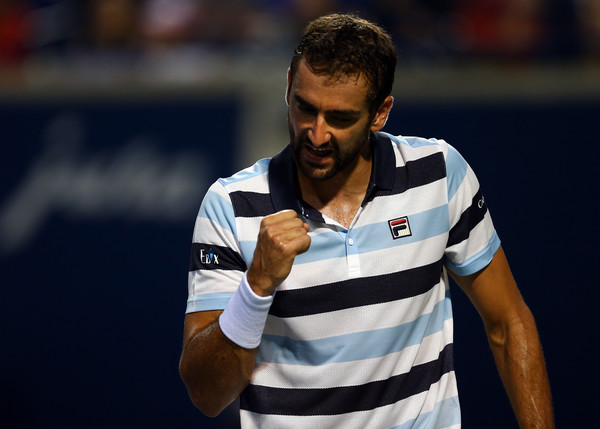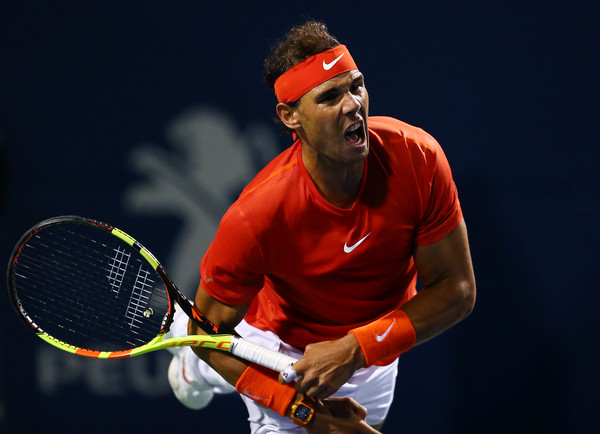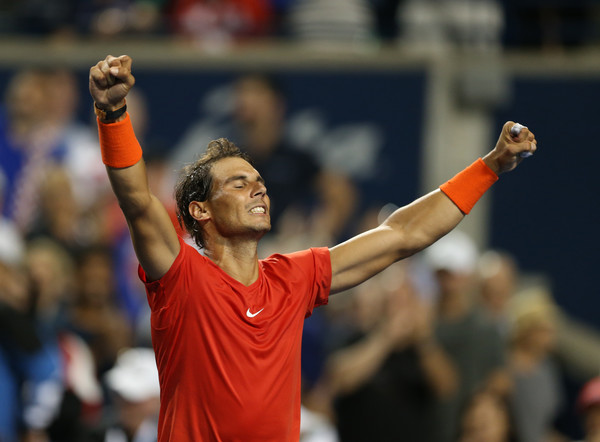Rule number one of the ATP World Tour: Never count Rafael Nadal out. Despite being down a set and being massively outplayed, the world number one showed why he is currently the best player in the world, roaring back to reach the semifinals of the Rogers Cup with a dramatic three-set win over Marin Cilic.
It was the sixth-seeded Croatian having his way with the top seed through the first set, seemingly striking winners at will and bullying Nadal around the court. But the Spaniard showed his trademark perseverance, weathering the storm and eventually turning the tables. He would break late in the last two sets to claim a dramatic 2-6, 6-4, 6-4 victory.
Cilic dominant
When Cilic is taking free swings at the ball and connecting, there is very little anyone can do to stop him. He was in one of those zones at the start of the match. At 1-all on Nadal’s serve, he was cracking his forehand and blowing the Spaniard off the court. A big forehand drew an error to set up a 15-40 opening, which he converted with another big forehand. It was the same thing two games later, as more big forehands allowed him to secure a double break.

Nadal had opened the match with a hold, to which the Croatian had responded with five consecutive games. He nearly made it six as the top seed served to stay in the set at 1-5. More big hitting drew errors from Nadal to set up a 15-40, double set point opportunity, but Cilic netted a forehand on his first before Nadal ripped a forehand winner on the second. The Croatian had two more break points at 40-AD but sent a forehand long on the first and the Spaniard saved the second with a volley.
The small signs of a turning tide came as Cilic stepped up to serve out the set, but they were brief. For the first time in the match, Nadal got into a Cilic service game, forcing a deuce before the Croatian polished off the game and the set 6-2.
Balance of power shifts
Cilic very nearly took a stranglehold on the match in the opening game when Nadal netted a backhand on his own serve at 30-all to go down break point. Fortunately for the top seed, the Croatian sent his return long. The momentum would start to shift into Nadal’s favour until the fourth game when it seemed as though Cilic fell off a cliff. After refusing to miss all night up to that point, the Croatian committed four straight forehand unforced errors to surrender the break to love.

The sixth seed quickly bounced back in the following game, going ahead 15-40 and held four break points in the game. However, he failed to put a single return in play on the break points, allowing Nadal to hold. The Spaniard would maintain the lead until serving for the set at 5-3. Cilic’s big-hitting returned and a bunch of big backhands gave him another 15-40 opening. This time he would strike a clean forehand return winner up the line to reclaim the break.
Just when it seemed that things were all level, with Cilic one point from tying the set up 40-15 on his serve at 4-5, the momentum swung again. At double game point, Nadal threw up a lob, but what should have been an easy put away for the Croatian was miss-hit several meters beyond the baseline. Cilic then missed an easy midcourt forehand to send the game to deuce. After a forehand into the net gave Nadal set point, the Spaniard threw up a couple of soft lobs that caught the baseline, leading Cilic to fire a forehand long to drop the set.
Nadal in charge
Any tentativeness Nadal had shown in the early stages of the match was gone by the start of the third. He was now attacking far more often, pushing the ball deep and keeping Cilic moving. While the Croatian was still hitting well, he was no longer overpowering the world number one.
Another implosion nearly cost Cilic in the fourth game, as he blew a 40-love lead before once again over-hitting a soft Nadal return go down break point. This time, he was able to recover and hit a forehand winner before holding. Still, despite defending his own serve, Nadal was now defending his own games with ease, giving the Croatian no chances to seize the initiative.

Once again, the tenth game with Cilic serving to stay alive at 4-5 made the difference. Nerves seemed to be getting to the sixth seed as some tentative play and errors, capped off by a forehand long, dug him into a love-40 hole. Down triple match point, the Croatian went down swinging. He saved the first match point with a big serve and the second with a backhand winner but sent a backhand wide on the third to hand victory to Nadal.
By the numbers
Statistically speaking, Cilic was actually the slightly better player in the match. He won 71 percent of his first serve points, 54 percent of his second serves (a high number when playing Nadal), and struck five aces. Nadal had four aces to four double faults, only put 59 percent of his first serves in play, and won a mere 46 percent of his second serve points.
The real difference was break points. Nadal was stellar, saving 11 of the 14 that he faced while converting three out of six. In the end, Cilic actually won three more points than Nadal.
With the win, Nadal becomes the first person to qualify for the ATP Finals in London this November. He will meet first-time Masters 1000 semifinalist Karen Khachanov in the final four in Toronto. The world number one has never dropped a set in three meetings with the young Russian.










































